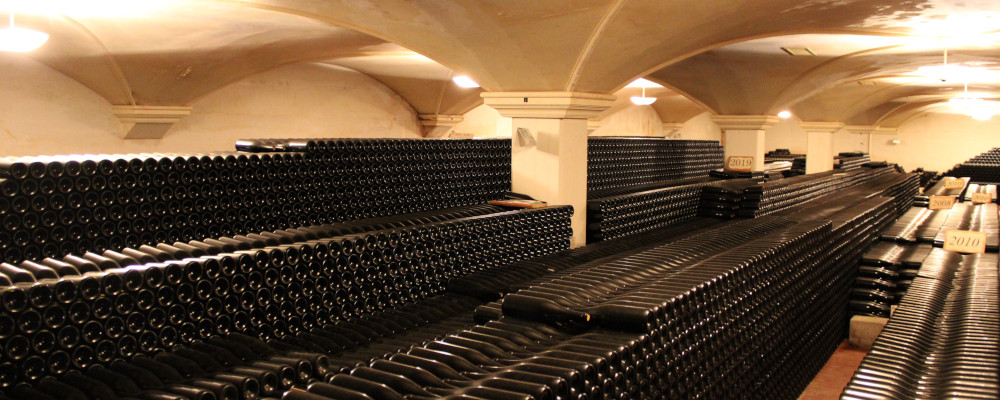The word cellar is both a noun and a verb. The latter meaning to simply put something in a cellar, though it usually is referring to a bottle, or more, of wine. In modern usage, one doesn’t have to cellar wine in an actual cellar. Wine can be put down in a purpose-built fridge, or in a corner that’s consistently cool and dark enough to allow the wine to age gracefully.
Merely having a cellar (or cellar-like storage place) is not enough for a successful venture in cellaring, though. As the Cambridge historian Helen Bettison writes, one also requires a wine that’s suited to be aged, and “some form of capital investment is usually necessary”. Actually, it’s worse than that: cellaring wine doesn’t require the willingness to pay for wine today that won’t be drunk for many tomorrows, it also requires the willingness to assume the risk that after several years of waiting what comes out of the bottle might not be any good.
Of course, the wines that are, by conventional wisdom, worth cellaring are almost always more expensive by orders of magnitude than those that aren’t. So, it’s little wonder that the great majority of the bottles of wine bought in the world are consumed within days, if not hours, of being purchased. And these wines are accordingly made to be enjoyed young. (For the purposes of this column “wine” refers to red wine, though there are many white wines that are suited to ageing.)
In fact, it’s reasonable to wonder why any wine is made to be cellared at all. Household wine cellars, as opposed to those in wineries or other buildings of commerce, are largely the invention of the wine trade from the 17th century on. Wine shipped from the port of Bordeaux to lucrative markets in London, Amsterdam, and Edinburgh would have had to have been stabilized, perhaps with sulphur compounds but surely with the astringent tannins from grape skins (especially Cabernet Sauvignon) and the oak barrels in which it was contained.
Stabilization is a fancy way of saying the wine was treated and made to inhibit living things from growing in it and spoiling it. Most wines now contain trace amounts of sulphides because their molecules bind with oxygen, which many bad bugs need to thrive, and of itself causes oxidization, a chemical degradation. So-called “natural wines” that are made without sulphides typically rely on tannins, drawn from long contact with the skins or even stems for extra astringency.
Very tannic wines are unpleasant to drink young; they dry out the mouth, like sucking on a teabag. This effect is commonly referred to in tasting notes as “gripping”. Before modern winemaking technology, like temperature-controlled fermentation tanks, tannins were a valuable and sought-after tool to keep wine from spoiling on its way to market. (Hops in beer perform an analogous role and were widely developed as stabilizers by the traders of the Hanseatic League.)
The trade-off for a London wine consumer, whose odds of receiving an unspoilt case of Claret were improved by the tannins in the wine, was that he would have to age the wines for some years before they were pleasant to drink. If you were (or are) the owner of a large house with a cellar and had (have) the capital to routinely buy wine en premier, or just by the case, then these wines would suit fine, since one could manage a rolling inventory of young wines in and old wines out. (Restaurants with big wine lists work this way.)
Does this make sense in the modern era? Like all answers to wine questions, it’s “it depends”. And like most answers to wine questions, the follow-up reason for why it might make sense is “because it’s fun”.
For most of my career as a wino, I did not cellar much wine since I lacked the simultaneous possession of Bettinson’s three criteria. What capital I had to spend on wine I tended to use to buy widely as I could, eager to try and enjoy many different styles of the stuff. I had a small fridge where a few prize bottles would sit for a while, but even then the temptation to open them would eventually become too strong to resist and the rate of depletion would sometimes exceed the rate of acquisition. Finally, as a journalist, I was fortunate enough to get in front of a fair amount of older wines at tasting and events, so at least I had some “lived experience”.
This began to change in the last few years. First, my wife and I renovated and expanded our house, and a storage area was added to the basement, under the new stairs. I had room. Then, the lockdowns of the pandemic changed the way I bought wine so that I bought a lot more of it, including “age-worthy” more expensive bottles, by the case. Since the cases of wine had to be stored in the short term in the cellar, I began to segregate bottles to different shelves and would put a few in the ones I set up for keeping.
Apart from the metaphysical thrill of drinking something old (what were you doing in 2012?), there are physical benefits too. In my experience, mid-range reds ($20-$40 a bottle) hit a kind of sweet spot at three to five years from vintage, though are often sent to market at two. Even if they are not particularly tannic, they seem to settle and some extra fruit is released.
As for the expensive wines that really are made to be cellared, the classified growths and luxury brands, I try hard to keep them down until they are a decade from being grown and picked. What I hope for is that they will have opened up, softened their grip without losing all their structure, and will reveal the core of their fruit character as well as the so-called tertiary characteristics that come with ageing, like earthiness, cedar, tobacco, or whatever.
In a conversation earlier this year, the Australian-based Master of Wine Neil Hadley remarked in passing that he thought that no wine benefited from more than 15 years of ageing. He didn’t mean that no wine couldn’t or shouldn’t be aged for longer, just that whatever chemical magic happened in a cellared bottle would likely have run its course by then. After the peak might come a plateau, though the risk of decline would also be present.
I have tasted just enough really old wine, say 30 or more years old, to know that at some point they kind of all taste the same. The flavours that made them distinct sort of melt into a raisiny rusty blur in the glass, which is best drunk quickly before exposure to oxygen kills what’s left to savour. It’s not unpleasant, but when a really old wine, like a 50-year-old Bordeaux or Barolo, still sings with fruit it’s a very special thing, and I am always grateful for whoever spent their capital on the investment.
Recommended for You

Malcolm Jolley: The comfort of familiar favourites—or the fun of finding new wines?

Malcolm Jolley: An ‘Elbows Up’ wine project everyone can get behind

Malcolm Jolley: Need some summer wines? Look no further than the food-friendly, low-sugar sippers of the sunny Southern Rhône

Malcolm Jolley: Need a date-night drink? French Northern Rhône wines are worth the investment




